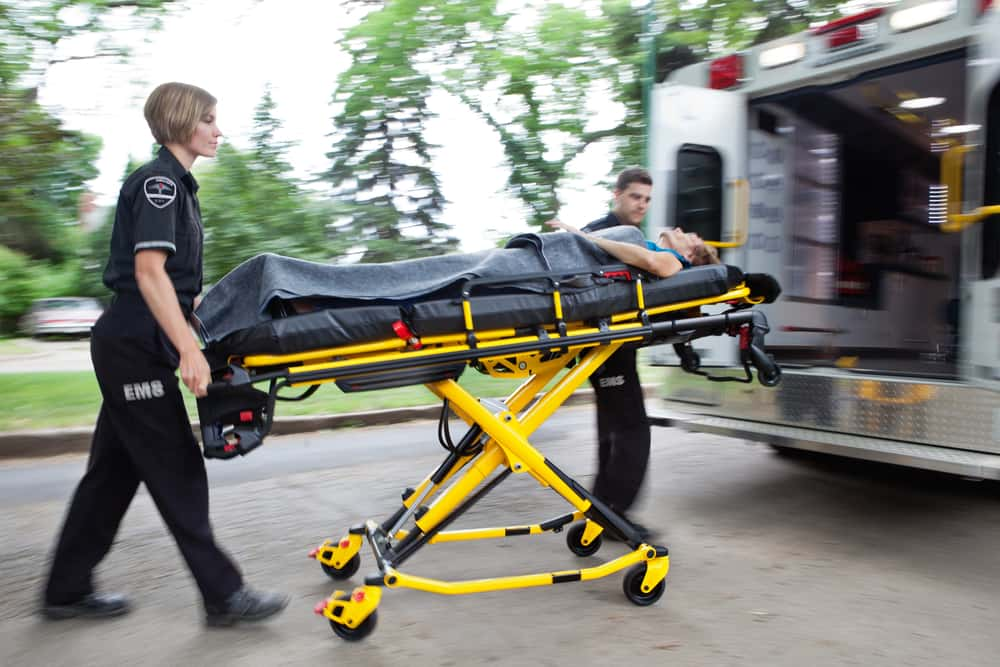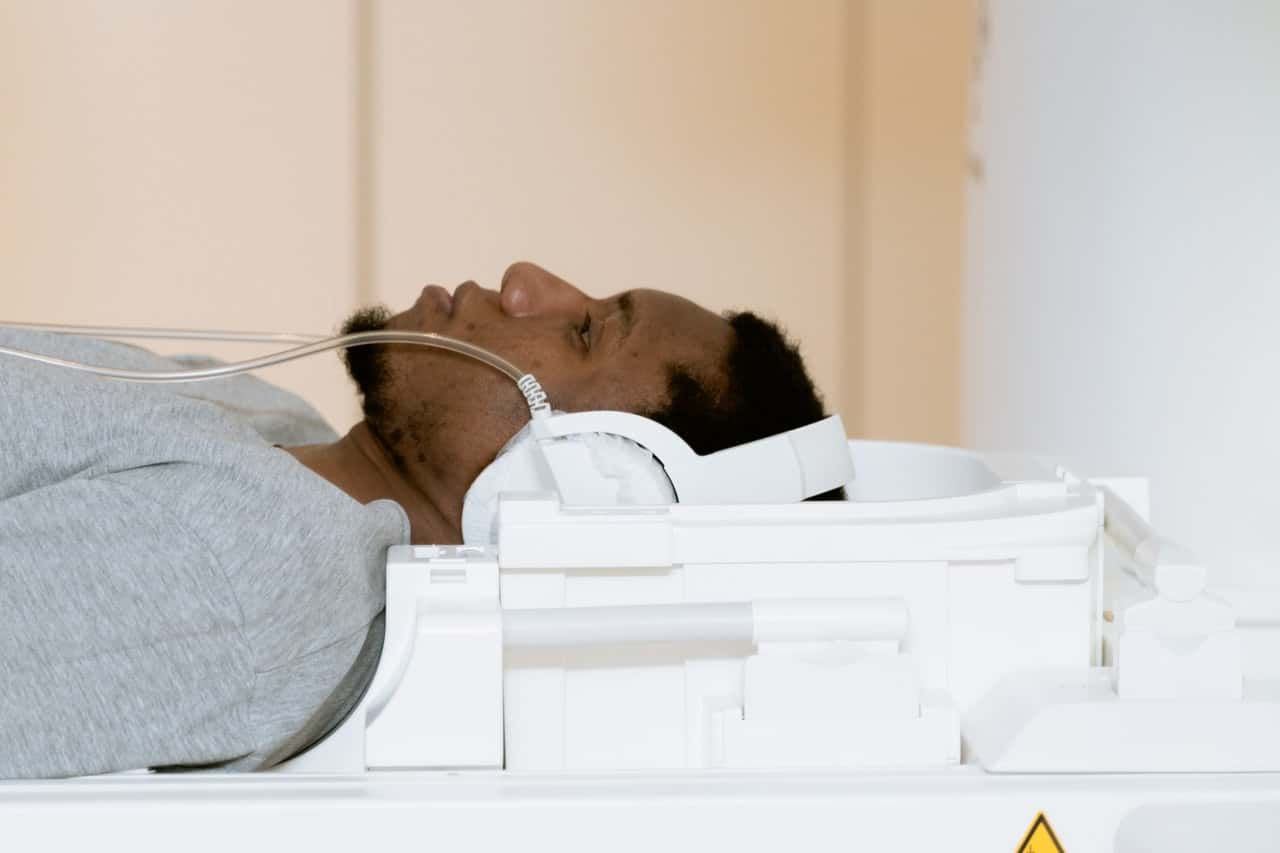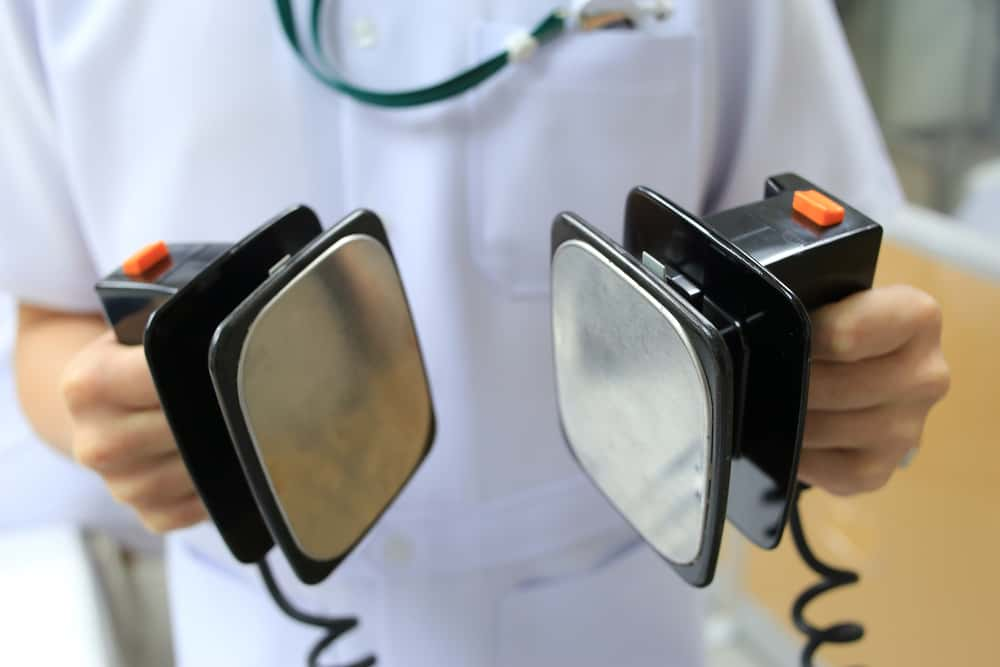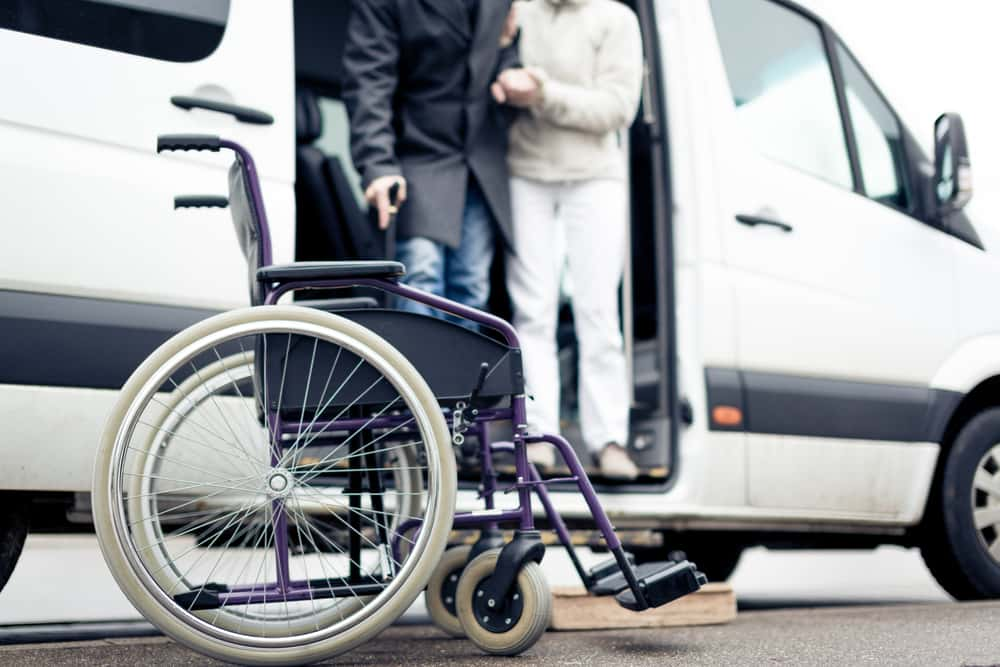Imagine dropping suddenly to the ground after a tough workout, with no discernable vital signs. Imagine falling, only to be impaled by a piece of rogue construction equipment. You’d think your chances of survival would be slim, right? That’s what these medical professionals thought about their patients, but they were wrong. Here are the shocking true stories of medical marvels that these doctors, nurses, EMTs, and anesthesiologists shared on Reddit.
1. Wear Seatbelts, Folks
I'm a doctor, and this happened during my off-hours. I witnessed a sedan with a trailer flip four times at about 120 km/h on a highway into a ditch right in front of me. The scene was shocking—A 12 year old wasn't wearing a seatbelt and was thrown from the vehicle through an open window. He had a superficial laceration of his leg and was in shock, but otherwise, he was apparently unharmed.
We did a quick trauma evaluation of the family and everyone seemed okay. I applied pressure to the kid's bleeding leg until EMS got there. When we were running to the wrecked car as the dust was settling, I was sure we were just going to see disembodied pieces of that kid everywhere—but that's not what we saw at all. He was FULLY intact; just really, really lucky. Wear seatbelts, folks. Everyone who remained buckled in the car didn't even have a scratch.
2. Shook
Both of these cases occurred during the Nepal earthquake of 2015. The first case involved an infant who had a roof fall on his head. He was trapped for 10 minutes before being rescued and it took another three hours to drive him to the nearest functioning hospital (this happened in a remote area and he was brought in by taxi). His face was so swollen that it was probably more than double its original size.
The doctors who examined it couldn't believe it—the top of his head was completely flat (like a dinner plate) and he had raccoon eyes. But somehow, he was showing no danger signs and his vitals were normal. A CT scan miraculously showed that there was no brain damage or even an actual fracture. He had something called a ping-pong fracture. The child recovered pretty well and was discharged in a couple of days.
The second case involved a lady who was roughly eight months pregnant. Again, the roof of her house fell on her, sadly on her belly. From what she said, she was stuck under the rubble for about four hours, and it took a further two or three days to airlift her to the hospital. An X-ray of her pelvis was done which showed that it was broken badly in at least four places. But that's not all it revealed.
Miraculously enough, there was very minimal bleeding. Someone with a pelvis fracture can bleed to death easily, and she had multiple fractures in her pelvis. Nobody can say what happened for sure, but it was thought that probably the weight of the rubble was so strong that it actually helped stop the bleeding due to the applied pressure. Even crazier, the baby showed no signs of injury or even stress, even though the roof fell straight on her belly. It was delivered healthily via C-section.
3. Legless Lumberjack
I helped take care of an old dude who had one leg amputated, and the other leg broke into two. He was on oxygen and not very compliant with using his wheelchair. We were talking with him and he was getting really argumentative. “How am I supposed to chop wood in a wheelchair”? That was what he kept demanding.
When asked how he was chopping wood with one leg in the first place, he responded that he’d crawl into the woods and hop up to chop the wood. This was even more concerning. When the doctor asked how he was carrying his ax, oxygen, and the wood all at the same time, he looked him straight in the eye and said, “I carry ‘em on my back”. Not sure if he was serious, but he was pretty dang grizzled and he looked like he may have been crawling through the woods.
4. Cut Up
It was one of the ICU patients. He was brought in awake and alive following a street incident. What happened to him was horrible—he was sliced approximately 50 times with wounds to the scalp, chest, and abdomen. He was admitted to the ICU after they had repaired wounds in his heart, bowel, stomach, and liver. On day one following his surgery, he wanted his breathing tube removed. I still wonder what he is made out of. Some days I think I met the T-1000.
5. You’d Better Run
I am an EMT. Once, a man banged on the window of the fire station and I rushed to aid the man. He got in an altercation with his brother-in-law over supposed stolen property and the man had been hit by a slug and beaten in the head with a bench, He was losing blood quickly...but the crazy part is the man ran to the fire station in fear...for 15 MILES while bleeding out!
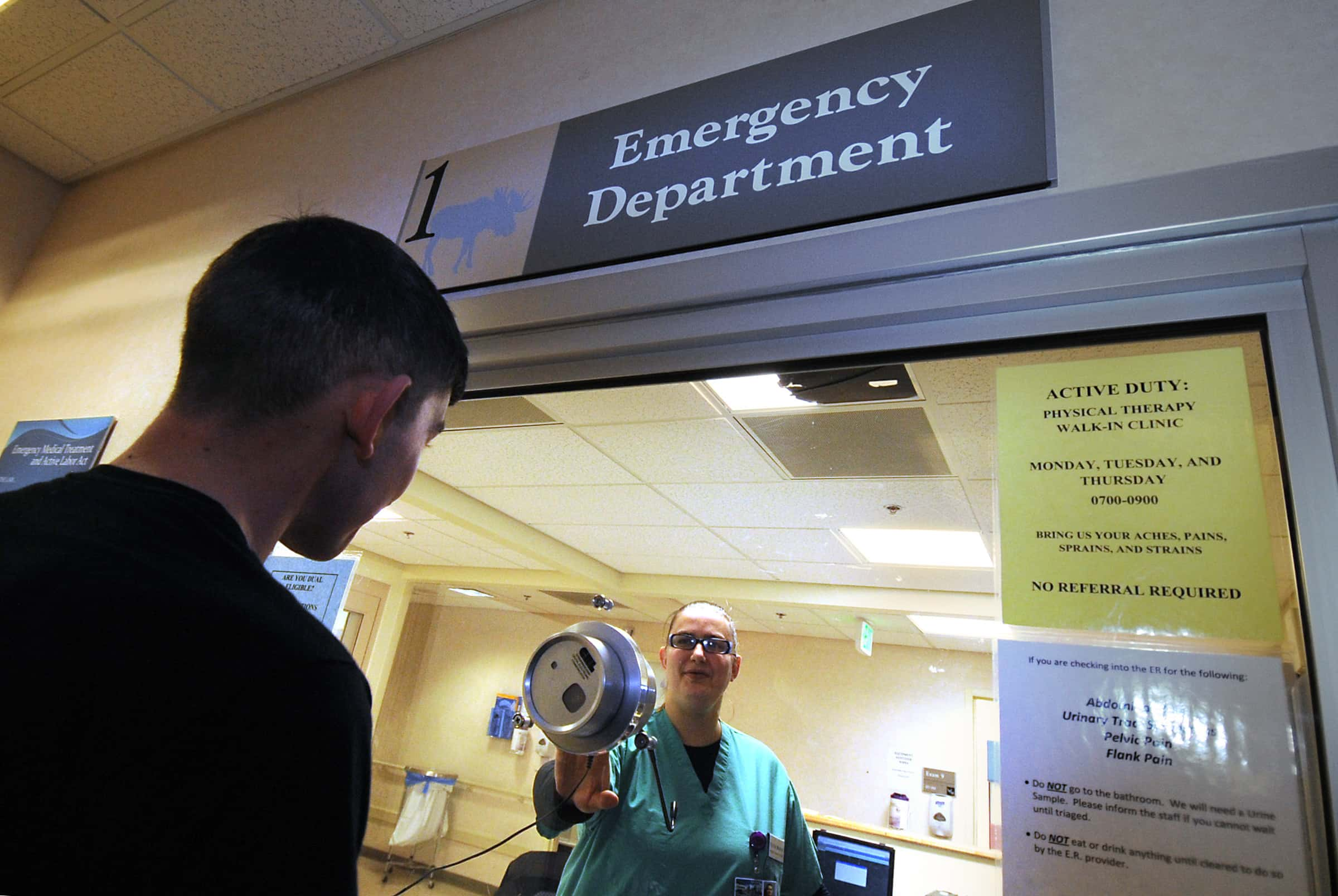 Joint Base Elmendorf-Richardson
Joint Base Elmendorf-Richardson
6. A Long Way Down
Med student here. My most memorable patient was a particularly pleasant middle-aged man who was flown back to my hospital in the midwest after suffering a six-story fall from a hotel balcony in the Caribbean. The poor fella had just arrived at his hotel planning to spend a week in paradise. Immediately upon arriving at his hotel, he stepped out on his balcony to watch the sunset and leaned on the railing only to have it collapse underneath him.
He fell six stories straight down and suffered bilateral open tibial pilon fractures (which are particularly high energy and difficult to heal). The aftermath was ghastly—the poor guy apparently fell into a locked backyard and his wife and kids had to listen to him screaming in pain and bleeding for over two hours before they could get the fire department to break down the gate.
He was taken to the hospital on the island where he was staying, and he was stabilized. The doctors recommended that he have both his legs amputated. He begged to be shipped back to the United States, and apparently, the government got involved and flew him to Miami where he was externally fixated and transfused several times.
About a week later, he was shipped up to the midwest to my hospital. It literally blew my mind the stuff this poor guy went through. Sadly, I think that he ended up losing one of his legs anyway because his wounds wouldn't heal and he ended up with osteomyelitis (bone infection).
7. One Too Many
I’m still fairly new in my training but this was one of the first crazy recoveries I’ve seen: A college kid was out drinking with his buddies and he drank a bit too much. He presumably aspirated some of his vomit and it caused this massive inflammatory reaction in his lungs called ARDS. He went from perfectly healthy to being close to the grave within an hour.
He got transferred to our ICU in the middle of the night, completely unstable, on a ventilator, and maxed out on five pressors (life support meds to keep your blood pressure up), He was being considered for ECMO (basically like a temporary machine bypass of your heart and lungs, used as a last-ditch effort to save someone). Things only got more chaotic from that point on.
His parents were on a last-minute flight from out of state with no bags packed to get to their son. Our team was concerned that he wouldn’t make it through the night and braced his friends for the worst. The treatment for ARDS is actually something called proning, which is when you literally just flip the patient onto their stomach.
And miraculously, two hours later, he was off all pressors, maintaining his own blood pressure, and—while very sedated from all the meds—he was able to respond to voices and shakes, and he could nod his head in response to questions. He made a full recovery four days later! (And vowed to stay away from booze for a while).
8. Do The Dew
ER nurse here. The case that immediately stands out in my mind was the diabetic who was, of course, noncompliant with her regimen and came in feeling horrible because her blood sugar was high. How high? Try just below 1300. For reference, diabetics are supposed to manage their blood levels and keep them no higher than 180, and even that’s kind of pushing at the limit.
By all accounts, this girl should have been in a diabetic coma at best. Yet SOMEHOW, fate was on her side—she was conscious, walking, talking, and arguing with us every step of the way. Despite the fact that her pee was almost pure sugar (and resembled crystallized honey), it was a 20-minute argument to get her to stop drinking her diet Mountain Dew (she firmly believed that the fact that it was diet meant it was fine).
Her blood was syrup. How we got enough to run blood tests was a minor miracle in itself. She kept complaining and asking for snacks, and she was just not a pleasant person at all. Obviously, she had to go up to the ICU. 20 minutes after we got her up and transferred, she walked out of the hospital. Why? She was mad that they only would give her water to drink. Priorities, I guess? Haven’t seen her since, but I still wonder about her from time to time...
9. The Outlier
I followed this patient with my attending. The patient was a 19- or 20-year-old African-American with sickle cell anemia. He was stroked out and he was in a coma. They had him intubated and put on a ventilator because he couldn't breathe on their own. The MRI was so, so bad—it looked like somebody emptied out an artillery magazine and scattered the pellets around the brain.
I still haven't seen another MRI like that one. With the brain, there is essentially a three-day rule. If you have a little chance of survival three days after a neurological injury, the chances of meaningful recovery are slim. Week one went by and his daily spontaneous breathing trials failed, so the patient was kept tubed and vented.
The second week went by and there was still no change in the patient's status. My attending and I were reviewing his case, and we decided that the next morning we were going to encourage the family to withdraw care. Friday morning, we went in. The spontaneous breathing trial had failed but the patient's eyes were open and following us around the room.
His eyes hadn't been open before. My attending and I were absolutely shocked. We were convinced this kid was essentially deceased based on the lack of brain function, but we'd just been proven wrong. Still, we didn't hold out much hope for more improvement. That Saturday or Sunday, we were able to safely remove the breathing tube. Another week went by, and the patient was able to move his head, arms, and legs around. Another week went by, and they were able to sit at the edge of the bed.
During this time of rapid improvement, he still lacked fine motor skills and could not produce coherent speech. He would get frustrated, tearful, and despondent. In discussion with the family, I made the comment to my attending in private that the patient appeared depressed. My attending brought up the likelihood of depression and the mom just scoffed. Her response was unbelievable.
"He has nothing to be depressed about! He is alive!" We argued our case for depression with her. "A month ago, he could walk, talk, and eat without assistance. He cannot do any of those things now. His life won't ever be the same. He has every reason to be depressed". She was still in denial about the prospect of her child being depressed in that situation.
The patient was discharged to rehab a few days after that conversation, and I don't know what happened to him after that. I don't believe in a higher power, but that was a very significant and completely unexpected recovery. Everybody involved in the care of that patient was sure that he wasn’t going to make it, and we were all proven wrong. It's a nice reminder that there are outliers.
10. Riding The Rails
My resident called me urgently one night and said I needed to come to the hospital. Nothing could have prepared me for what I saw that night—a young man was cut in half by a train. I asked why I needed to come in, as there was no way he could survive that. She explained that somehow he was maintaining his pressure and wasn’t bleeding out. When I arrived, I found that the force of the train had sealed off all the major vessels from the pelvis down!
11. Case Study
When I was in college, there was a kid that exited a freeway at near freeway speed. But there was one big problem—it was a construction zone at night, with no lights, and it wasn’t supposed to be an open exit. He drove right into a pile of rebar. One of the poles went through the car into his face and pinned him to the seat through his head. A couple of years later, I was in grad school in an anatomy seminar, and the surgeon presented that kid's case as a study.
But here's the crazy part— not only did he live, but the rebar had also slid right past the base of the brain and spinal column. It was so close, that they had to twist it out like a screw because the ribbing on the bar threatened nerve damage. They literally rebuilt this kid's skull around his brain. His recovery photo was of a totally normal kid smiling. He had a small scar on his chin. I say kid, but he was like 17, just to be clear.
12. Eat It
A guy forgot his keys and was climbing back into his own apartment through the window. His cousin thought that he was an intruder and he acted rashly in a split second—pointed a shooter at him and pulled the trigger. The round went into his mouth and exited clean out the back of his neck. After surgery, he was totally fine in a few days. It somehow missed all major structures. Didn’t even chip a tooth. He was really angry at his cousin, though.
13. Hello Nurse
One of my prior patients is a roofer who lived a very full life of booze, women, and substances. He was infected with HIV, hepatitis B, and hepatitis C, and he didn't really care about his health at all. He was ghostly thin and weighed 110 lbs on a six-foot frame, which included 20 lbs of ascites (fluid) in his abdomen.
He was angry and didn't listen to anyone, refusing therapy most of the time. I met him first in the ICU, where his health had mind-boggled all the doctors. He had full-blown AIDS, end-stage liver disease, hepatorenal syndrome, unexplained lymph nodes all over his body, variceal hemorrhage, Kaposi's sarcoma, and spontaneous bacterial peritonitis. The prognosis of in-hospital failure was more than 90% even with therapy.
I was involved in his care for about two weeks and he again refused every therapy that his primary physicians suggested. I was surprised he lasted the two weeks. Finally, he was so fed up with the noisiness in the ICU that he requested a transfer to palliative care, and he was eventually sent to a hospice for patients with advanced HIV to live out his remaining few days.
One year later, I got a most surprising call from the hospice—they were requesting a follow-up appointment for him. I was shocked that he was still alive and asked if I could talk to him. He was all better. Turns out, he had the hots for his nurse in the hospice and did everything she asked in order to please her, including taking his medications for the first time!
She had slowly nursed him back to health, convinced him to restart HIV meds, put him on a low salt diet for his liver disease, and then eventually got him up and mobile. He spent another six months in a rehabilitation facility, then went back to work. He saw me for follow-ups for a while as we treated his hepatitis C, then his cirrhosis shockingly improved. After a couple of years, he moved away to another place to start a construction company and he became rather successful financially. He remains abstinent on his former vices. He's the only person that I've seen come back from the grave.
14. Strange Virus
I had a patient who had severe viral meningitis from a previously unknown virus and he almost kicked the bucket. He was fine for a year, but then he experienced yet another misfortune—he contracted an extremely rare infection typically found only in livestock, with only seven known cases in humans (at the time), following surgery to remove a large lipoma under the knee. The wound was incorrectly stitched—one wasn’t removed—and the wound healed over it, leading to subsequent infection.
I don’t quite remember the name of it (I’m only a GP), although it wasn’t considered zoonotic on account of you having a higher chance of getting struck by lightning three times. Again, they almost didn’t make it. It was a standing joke that they were a walking biohazard. It was only a matter of time before they contracted something that transferred to us all.
15. Can’t Stop Me Now
I had a patient who came into the CCU in cardiogenic shock. We proceeded to intubate, code him for two hours, and shock him 13 times until finally, we were able to place an intra-aortic balloon pump. He was unresponsive at this point. I went to the family to update them on the patient. I explained that we got his heart beating again, but given the prolonged CPR and prolonged hypotension, there was a significant chance that his neurological status would be severely affected and would almost certainly never be the same again.
I brought them into the room and after a tearful reunion with their loved ones, I headed out of the room and to a computer to start charting the firestorm that just happened. A few minutes later, the man's son came out and he uttered words that gave me chills: "I think my father is trying to tell me something". Now, I hear this a lot from family members who are in severe grief after their loved ones suffer a severe brain injury, so I'm skeptical, but come in to assess the patient.
To my disbelief, the guy was wide awake and talking around his breathing tube. He followed my commands and wrote out that he wanted to be extubated on a piece of paper. He was 100% neurologically intact. We eventually extubated him after getting enough fluid off with dialysis and he did well over the next few days...until he ended up developing severe septic shock and passing away.
But for that brief period of time, I was flabbergasted.
16. Close Call
The best one I saw was this guy with a GSW in his back, half an inch from his spine. He was totally stable, sitting and talking to us. He walked out a day or two later with—get this—just a Band-Aid. If it was literally a millimeter, either way, he would've been a corpse.
17. Creepy Crawly
When I was in medical school (in a third-world country), there was a patient who came into the clinic because of his diabetic foot ulcers. The ulcers had basically eaten away at any viable tissue left in his foot. This didn’t baffle me much because they’re unfortunately quite common there. What made me squirm was something else entirely—the living, wiggly things I saw within those ulcers on closer examination.
I spent the next week soaking and re-soaking the foot in saline and some other solution and slowly extracting those maggots out. After all that, we were actually able to save his foot! He got crazy lucky but I still never understand how people let things get SO BAD before they decide to come to see a doctor. Let this be a lesson!
18. Overly Prepared
I was a respiratory therapist. I was working on the hospice floor and we got a patient who was admitted for end-stage esophageal cancer to the point that she couldn't eat without a tube. The doctor gave her no more than a few weeks. So, the weeks went by and she seemed to be looking better. A few months went by and they took the tube out because she passed a swallow evaluation.
But the biggest miracle? They did a scan and she was cancer free. She was so angry. She had sold her home, given personal items away, etc as she was preparing for the end. I still remember her yelling, "Well, where in the world am I supposed to go"? Weirdest case I have ever seen.
19. Perseverance
I once had an elderly patient come to the hospital. He was apparently enjoying his day at a lake around 5 km away from the town. He started to feel dizzy and weird around the arms (general signs of heart attack) and surprisingly decided to "swim through it". This dude proceeded to swim across the whole lake. That was strange enough, but it gets even stranger.
He then started to feel even worse and went to the town hospital all by himself on foot. He was pretty screwed up when he got there. They later found out he had gone through a relatively severe heart attack and had to get surgery the same day. The guy managed to live but man, it still sounds pretty hardcore to swim through a heart attack, then walk to the hospital by yourself.
20. Picture The Elevators In The Shining
I delivered this woman's baby and it came out in good condition. A few minutes later, she experienced a major postpartum hemorrhage. I could not get the bleeding under control. We were pumping blood into her as quickly as it was pouring out. She went into DIC and became delirious. She lost more blood than she had in her and eventually she had a full hysterectomy.
She was black and blue from where we had tried cannulating and the room she was in was basically red. I have never seen so much blood in my life. But even after all that, she made it through. In fact, she was out of intensive care after two days and was allowed home after a week! I still do not know how she survived.
21. It’s A Sign
I’m a paramedic. I had a guy walking in the street who got hit in the head with a stop sign that flew through the air after a motorist slammed into it. He was literally impaled in between his eyes with the sign. Like part of the “S" was in his skull. The security video showed the sign and the pole swinging through the air before hitting him. But he took us all by surprise—he was talking and alert the entire ride to the hospital. Walked out post-surgery a few months later. Amazing.
22. You Are What You Eat (Or Don’t)
I was in the ER and this woman, about 26 years old, went to my consulting room. She told me she had been feeling really weak and that she just slept almost all day with constant nausea...but what was really odd to me was that she was incredibly pale, almost like a ghost. So I decided to ask regular questions, like when her symptoms started and the like.
Apparently, she hadn’t eaten for almost a month. I decided to request some tests. She had 2.4 mg/dL of hemoglobin, which is super low considering the normal range is above 12 mg/dL. Not only was that pathological, but based on physiology books, that level is incompatible with life. How that woman was alive is beyond me.
23. Weighty Matters
I had a patient with Fournier's gangrene (necrotizing fasciitis of his perineum. He had uncontrolled diabetes, weighed 450 lbs, and was drinking a 20-pack every day. He came into the hospital with diabetic ketoacidosis in addition to the necrotizing bacterial infection of his groin. We debrided his privates—and then everything went into chaos.
He went into delirium tremens and septic shock, and he also had full-on kidney failure and liver failure. It didn't look good for him, but by some twist of fate, he ended up having a full recovery after two weeks in the ICU. Kidney function returned. Plastics ended up helping him put a flap over his perineum.
24. Take A Breath
I’m a nurse, and I worked at a small county ER. I had a guy drive himself to the ER and while he was checking in, he suddenly went into respiratory arrest. He was a big guy with not much neck plus angioedema (swelling in the mouth), so we really struggled to get an airway on him. We lost his pulse numerous times and had to perform many rounds of CPR. We also performed several defibrillations and used every medication in the code cart plus a few others.
I personally broke at least three or four of his ribs. We somewhat stabilized him after an hour or two, and the only available ICU that could take him was a two-and-a-half-hour ambulance ride away. We finally shipped him out, all of us having to clean our scrubs due to blood splatters, and none of us were optimistic. Then, a month later, we were surprised by some shocking news—he called us from rehab and thanked us for saving his life.
25. The Iron Lady
This is the wildest case I’ve seen while covering the ICU: A young lady with cystic fibrosis got rushed into hospital after coughing up blood and collapsing at a concert. The ambulance told me she wasn't breathing for a good 10 minutes. I attempted intubation (the ER doc couldn’t do it) and all of a sudden, I was met with a fountain of blood gurgling up from her throat.
While waiting for the anesthetist, I desperately suctioned out everything I could and attempted a Hail Mary intubation. That's when my own blood ran cold—it went into the right hole and into the right mainstem bronchus, which was perfect since the patient was apparently having a massive arterial bleed from the left side. Desperately, I loaded her up with cyklokapron (an agent that reduces bleeding).
Ventilating her was extremely difficult and the blood gas results looked terrible. She wasn’t saturated with oxygen very well. I called the interventional radiology department and my ICU staff to come over and we quickly lined her up before she headed off to radiology. The interventional radiology gods stopped the bleeding and I went to talk to her husband. I tell him that she hadn’t saturated in a long time and that though she was stable at the moment, she might have severe neurological sequelae.
Turns out, I spoke way too soon—suddenly, the iron lady walked out of the freaking ICU less than 48 hours later. The whole team just stood there with their mouths open in complete disbelief.
26. Look Before You Leap
We had a kid who jumped onto a piece of rebar which was now running up into his bum, bowel, liver, and into his right lung. He and a few of his friends were skateboarding on new foundation forms at a construction site and he fell eight feet (2.4 m) down onto the rebar. He was transported to the ER with the rebar intact.
It took six hours of surgery to remove the three feet (1 m) of rebar. Eight months later, there was a surprising turn of events—he actually walked out of the hospital. Even though the kids were trespassing, the construction company was sued and they lost the suit because they didn't use the bright orange caps that went onto the rebar for safety. I haven’t seen anything like that since.
27. Pain In The Brain
I'm an ER nurse, and I wasn't there that day but saw the CT scan. We had a patient come in with a headache. She already went to another hospital where she was given meds. A couple of hours later, she came to ours. My understanding was that we were going to do much of the same. That's because unless it's the worst headache of your life, it's not worth the radiation you get from a CT scan.
During one of the examinations, she mentioned how she was in a parking lot and heard explosions. I don't know how she left that part out of the first visit. Well, we sent her over for her CT and her results had our jaws on the floor—there was a metal slug in her brain. The problem was that with the weave she had on and the original complaint of just a headache, no one saw any blood or indication that she was hit. She ended up getting transferred.
28. Outback Adventures
I worked as a student nurse in a major trauma hospital in Australia before I got sick myself. I worked in trauma orthopedics and loved every minute of it. We had a lot of really interesting cases, but this guy stands out because it's amazing he even survived. He was an ice addict and tried to drive from Port Augusta to Sydney in one night.
He flipped his car somewhere in the Outback in the middle of the night, but he was amazingly found in time and got airlifted to us. He had a fractured spine, open fractures on both his legs, a broken arm, and had his face was pretty well smashed up. Even though he was in a halo with two external fixators on his legs, he did something spectacular—he managed to escape to bum smokes out on the main road.
We couldn't work out how he stood up or walked without passing out, even with the number of painkillers he was on. We had to have security with him 24/7 and two at night because he hated the night nurses most. I kept my distance as much as possible but he was always fairly friendly to me...he probably didn't see me as much of a threat since I wasn't the one making him take his meds. I hope he ended up okay and got the help he needed, I left before he got released or sent back to Adelaide.
29. A Tough Pill To Swallow
I was doing a rotation at one of the poison control centers. We got a call that a teenage boy had swallowed an entire bottle of aspirin. He was in a helicopter on the way to the hospital and had already spiked a 108-degree temperature. At that temp, your brain is basically turning into jello. If he survived, they believed he would have severe brain damage.
They tried their best to bring his temp down and keep him alive. I left the poison control center believing that teenager wasn’t going to be alive when I went in the next day. But when I called the hospital to follow up on his outcome, I was flabbergasted by the news. I was told by a nurse: "He's doing great! He's been sitting up in the ICU having full conversations with the nursing staff. We're going to get him a psych evaluation, take care of him for a few more days, and hopefully release him shortly after that".
I was blown away.
30. Unicorn Man
I had a patient come in literally with an ax sticking out of his head. Like right in the center of his head jutting out like a unicorn horn. Apparently, he'd been doing some yardwork and set his ax on some platform above him. While working, he managed to jostle the ax so it fell right on his head. That was horrific enough, but that's not what really got me.
When I spoke to the guy, he did not seem to have a care in the world that there was an ax in his head. Nurses were wheeling him around and he was smiling and telling jokes, laughing the whole time. I was like, man I hope if I ever take an ax to the head I could handle it with such grace.
31. Self-Inflicted
I saw a patient with factitious disorder, a psychiatric condition where you pretend to have a disease or inflict a disease on yourself to play a "sick role”. This patient didn't want medications or housing, he just wanted to be a patient and be cared for by a medical team. We were treating this patient for bacteremia (bacteria growing in his blood) and he had sepsis when he first came in.
He was getting better until we discovered his disgusting little secret—he had been injecting human waste into himself to make himself sick. We looked through the medical records and found out that he had played similar stunts at other hospitals. I’m really surprised he hasn't accidentally gone too far or gotten a disease that we can't cure. It was such a crazy situation.
32. Monkey In A Tree
I was rotating on trauma surgery during my third year of med school. A call came in for a man impaled by a tree branch. He had been climbing a tree (while high on some substance) and at some point, he fell about 10 feet onto a lower branch. When they asked for the ETA, the EMS replied that he didn’t have one. You see, he was STILL IN THE TREE and the firefighters did not feel that the man could be removed without risking him bleeding out.
So a team of surgeons was helicoptered to the location and they were HOISTED up 15 feet (4.6 meters) into the tree along with some other personnel. Together, they were able to extricate the man from the tree with the branch still lodged squarely in his bum cheek. The man was then helicoptered back to our hospital with the surgeons and taken directly to the CT for a scan, which showed the branch had penetrated through the buttock, through the pelvic ala, and was lodged in his pelvis, either through or near two major vessels.
I got to scrub in and join the festivities. Up until he was being rolled back to the OR, he was conscious. He was on pain control meds obviously, but he was also positive for other substances, so we had to be careful about sedation since traditional methods of anesthesia can be harmful to someone on those substances. So he was like, “MY BUM!” and we were like, “We know dude, we know...hang on”. Little did we know what we would soon find inside him.
Anyway, we opened him up and identify the foreign object, which was like a six-inch splinter of wood..and this thing was lodged right between his iliac artery and vein...it was as if it was made to just slip right between the two. Had it penetrated either structure, this guy would not be alive. But it didn’t, so he was still here. He didn’t even have damage to any internal organs and we only needed to extricate a couple of teeny bone chips.
He had a good chunk of his gluteal muscles and skin removed and we put a wound vac on him. He was only in the ICU for a couple of days, and he spent maybe a week in the hospital. By the end of his stay, he looked great. Somehow, he looked ten years younger than when he first arrived. He also didn’t have a tree in his buttock, so there was that. Later on, he was discharged home with wound care instructions.
He did well in the short term, but I'm not sure what happened to him afterward as I was off the service the following week. I wish him well.
33. Full Of Holes
I was an EMT for a while and we were a downtown Los Angeles unit. We would post at the original LAC-USC trauma center between calls which was awesome because they had an observation booth. So one day, my partner and I were chilling in the ambulance waiting for a call when another unit came in with a multiple GSW to the chest and body.
Well, they ended up cracking open this person's chest and sewing together his heart and lungs closed since they were full of holes. At one point, the lead trauma surgeon made a bold move—while holding the guy's heart, the doctor injected epinephrine into the myocardial tissue. He waited a few seconds, then flicked his heart and it started to beat, while he was still holding it. It was the coolest thing I'd ever seen.
34. Baby Fever
I’m a nurse. I had a patient who came in for normal delivery, except she had no prenatal care because her husband "didn't believe in modern medicine". Everything was fine, and the patient was scheduled to go home the next day with her new baby. Then, the nurse went in around 8:30 pm to assess the mom and the baby, and she found the mom in a perilous situation—she was slumped over in the bed, essentially not alive. No breathing, no pulse.
It got really crowded in that room really fast as they coded her. They did CPR for about 40 minutes, intubated her, and shipped her off to ICU. Her husband was called to come in because he was at home with their SIX other children. We all thought for sure she was a goner, but she woke up three days later.
35. Deep Sleep
Anesthesiologist here. When I was fresh out of the training I had a patient in his 50s come in for hip surgery. I met him and his teenage daughter on the day of his surgery. He was a healthy guy except he had been in a car accident a few days prior. Other than a few rib fractures, all tests were normal.
I put him off to sleep, installed the breathing tube, and was just starting to put in an IV when I watched his heart slow down to a stop on the monitor. I immediately started the cycle of chest compressions, meds, and defibs. We did about 15 minutes of CPR while I tried to figure out what the heck was going on.
I kept picturing his daughter and how I was going to explain that I lost her dad on my table. Out of desperation, I put down a TEE probe to see if there was any trace of cardiac activity. Instead, I found something truly disturbing—there was a huge fluid collection around his heart that was preventing his heart from beating.
Within seconds, I told the surgeon and he opened him up to drain the fluid. Still, no organized heartbeat, but now his heart was fibrillating (moving in a way that doesn't pump any blood). This meant he could be defibrillated and we did another 15 minutes of CPR with shocks. We were at 30 minutes and it was starting to get to a point when we all knew it was going to be over. We all agreed to do one more round of CPR before calling it.
And that's when the miracle happened—the dude's heartbeat came back after that last round. It was faint, but it was there. It took another hour to stabilize him enough to get him up to the intensive care unit, but we made it. At that point, I was convinced he would stay intubated in the ICU and either never wake up or if he did, he'd be profoundly disabled.
I told his daughter what happened and that we would need to see how things progressed. The next morning, I went to check up on him and see if he made it through the night. The dude had pulled out his breathing tube at around three in the morning and was sitting up in bed arguing with his nurse about whether he could eat breakfast. His daughter was at his side shaking his head and teasing him.
The relief I felt was something I won't ever forget. I felt such a huge weight leave my body that I became dizzy and had to hold onto a chair to stay on my feet. I told him that though I wasn't religious, his case was the closest I'd come to seeing a miracle. I hugged him and his daughter and went about my day feeling like I'd stolen one back from the other side.
36. Achy Breaky Heart
When I was rotating in the ICU, we had a patient with a history of a bad heart basically collapse outside a clinic building. Some residents did CPR on the street and got his heart beating again. EMS took him to the emergency room and he lost a pulse again after he was intubated. We did more CPR and gave him anti-blood-clot meds because they thought that he had a blood clot in his lung which caused him to suddenly drop.
Unfortunately, we later discovered that he had a pretty bad brain bleed already. He was transferred to the ICU while he was neurologically unresponsive, and the family eventually decided that they wanted to pull the plug. They showed up five days later to say their goodbyes. That's when everything changed—he suddenly woke up and started to respond to simple commands and questions.
Last I checked, he was discharged from the hospital back to his normal self. A repeat ultrasound of his heart showed that it was pumping better than before.
37. On The Brink
A guy who was on blood thinners for a heart condition fell and suffered a traumatic bleed in the brain. We rushed him to the operating room and evacuated the clot without issue. We were just about to move him to a bed in the ICU when the guy flatlined. We immediately called a code and began CPR. We did CPR for almost a half hour, but there was no improvement in his condition.
The guy was a goner. The anesthesiologist looked at the clock and was about to announce the time when out of nowhere, we heard the fateful noise: "BEEP"—we had a pulse! The guy's heart amazingly started back up again. We immediately sent him for a CT scan and the guy's head bleed and looked fine. Typically, someone who has head trauma and codes for 30 minutes is basically a goner. I was convinced that he was done.
He was like a modern-day Lazarus. The whole incident really taught me to never be nihilistic about my patients, no matter how dire the situation may be!
38. When Hunger Strikes
I’m a nurse who worked in long-term care. I had a patient who was apparently actively dying. She had stopped eating for three or four days and was on comfort measures only. This meant that she was receiving morphine every hour and the rest of her medications were discontinued. She was also only being fed and given water as tolerated. Then, one day, out of nowhere, she made a mind-boggling announcement: “I’m hungry”, she told the nurses.
And just like that, she was back to normal. She lived for around another year or so after that.
39. A Tough Workout
Paramedic fireman here. I was called to help an old guy who dropped cold while on a treadmill. When I got there, he was asystole, which meant he had zero electrical activity in his heart. With one round of CPR and one round of ALS meds, the heart suddenly went into a shockable rhythm. This was our one chance to save his life. So, we defibrillated him one time, and the guy got back his normal heart rhythm with a pulse.
We loaded him up and had a five-minute transport. By the time we got to the hospital, this man was making jokes with us and would have walked in if we let him. This was not how cardiac arrests usually went. It was absolutely incredible to witness.
40. Out Of Spite
I had an elderly patient who presented with a severe kidney infection condition called “emphysematous pyelonephritis”. Normally, we would take her to the operating room and perform an emergency nephrectomy or removal of her kidney. However, she was unresponsive, hemodynamically unstable, and deemed too unhealthy to undergo major surgery.
As a last resort, we placed a drain tube into her kidney to give the bacteria a way out. She didn’t improve much after this. She was never really alert or had energy to get out of bed. She was eventually discharged to a nursing home for palliative care. A month later, I saw her in the clinic, and I couldn't wrap my head around it—she was completely coherent and furious about the nursing home.
Apparently, one of the other residents was bullying her and ruining a card game she liked to play. We admitted her to the hospital that day and did her nephrectomy. She had one of the fastest recoveries I’ve ever seen after nephrectomy, and she was in her 80s. It was an incredible recovery from where she started. In a messed-up way, that jerk in the nursing home saved her life by giving her motivation to get better.
41. Out Of Air
At the end of the night shift, around 6 am, I got called for a patient with metastatic cancer with hypoxia (low oxygen levels). It happened suddenly and he had a very fast heart rate, so we all thought he could have a pulmonary embolism (clot in the lungs). He was very panicked with shortness of breath and he asked us repeatedly to keep him alive.
We couldn't keep his oxygen levels up, so we decided to put in a breathing tube and hook him up to a ventilator. I stepped out of the room to call his son and as I was talking to him, I saw people running with a backboard. I realize he had coded ( that is, he went into cardiac arrest) and I had to tell his son in real time that his father may not make it. I had zero hope...but then everything changed.
The ultrasound of his heart showed that the right side was completely blown, suggesting a massive pulmonary embolism. We pushed systemic medications to lyse any clots in his body. He got a pulse back and we whisked him off to the ICU in bad shape. I went home and come back that evening to comb through his chart—I couldn't believe he was still alive.
He was found to have clots everywhere in his legs and lungs that morning. He was taken by interventional radiology to place a filter in the big vein leading from his legs to prevent more clots from showering into his lung, then he woke up and his breathing tube was removed. I visited him that evening and he was up and talking. Thankfully, he didn't remember anything.
42. Under Water
A man in his 30s was brought into my intensive care unit after drowning in a lake for roughly 30 minutes before being pulled out. His core temperature was 29 celsius, but the paramedics had managed to restart his heart on the way to the hospital. I wasn't holding out much hope for this guy, since 30 minutes underwater usually means either the end or permanent brain damage.
We put tubes into every orifice and created a few more for good measure. He was hooked up to a ventilator and a haemofiltration unit, then placed on a warming pad. Over the next 24 hours, we slowly warmed him back to normal temperature. Once his vitals were quite stable, we held off on his sedation and slowly woke him up while I off-shifted.
When I came back 12 hours later, I couldn't believe my eyes—he was sitting up and having a cup of tea. I walked past him that morning. He looked at me, and I looked at him. I felt like I'd seen a ghost. When he saw that look on my face he started to cry. One of the few times I've ever hugged a patient. He walked out two days later, and five days after the incident which by all accounts should have meant his demise. I will never forget him.
43. Reconstruction
During my internship over the summer, I had a patient that had fallen from a construction job on the fifth floor. He had fallen on his side with his arm up, thus protecting his head. He had multiple fractures on both his arms, pelvis, and legs. He had a urinary catheter installed and he was on a stretcher, unable to walk of course. We thought he would never be the same again...but the next day, his fate completely changed.
He had regained almost complete mobility in his arms and was starting to walk again. It was insane.
44. Double Heart
I was a nurse for a man who had a heterotopic heart transplant in the early '90s. That’s where they sew the donor heart next to the native heart and they beat in tandem. This is now an outdated practice and to my knowledge, it is not done at all in the US. Once he got to us, he’d had that donor heart for about 20 years (truly, that’s about the life of a transplanted heart), and both his donor and native heart were in full-blown failure.
But he was still young, so we slapped him on ECMO (a bedside heart and lung bypass) and brainstormed. They finally decided he qualified for a total artificial heart and they took him to surgery. They removed the native heart and sewed shut the donor (it adhered to his right lung. They then implanted the totally artificial heart. It was a total Hail Mary, and we all held our breath, waiting anxiously to see what would happen next.
Luckily, he had quite a recovery. Nine months in the hospital, tubes in every orifice you could imagine and then some. After he regained some strength, he was listed for transplant and successfully received a heart and two kidneys almost a year after he’d been admitted to us. The crazy part is that now he has two donor hearts in his chest.
45. Lumps and Bumps
I'm a doctor in a low-income country. I have a 13-year-old female patient who had a mass on her back about the size of a fist. She also had some masses on her right forearm and legs. A biopsy was done on her back mass and it revealed neuroblastoma. Based on studies, nobody survives that stage of her type of cancer.
Well, I offered high-dose chemotherapy but the parents could not afford the treatment. So I gave chemotherapy for stage two neuroblastoma. Turns out, that was the best decision I'd ever made in my career—the patient actually responded to the treatment and the masses disappeared as well as the lung nodules. We completed the chemotherapy and she is now cancer free. The patient is going to school and is doing okay. Sometimes miracles happen.
46. Total Transformation
Nurse here. I worked in a sub-acute nursing center some 15 years ago and I saw a lot of crazy stuff, but this one has stayed with me. I started working with this patient—he was admitted as “total”, meaning he needed total care. Completely paralyzed, he had to be turned and repositioned by hand every two hours. He also had a feeding tube and everything. He was with us for 90 days.
On Day 90, the entire staff was in shock—when they visited his room, he was up and walking with no assistance. He had no cognitive or physical deficits, and he was waiting for his barium study so he could eat again. The dude had a super rare form of vasculitis where his autoimmune response attacked the lining of his nerves, but he never got paralyzed.
I’ve had the pleasure to work with three out of five cases in my state. It’s common for these patients to recover some independence afterward, but he made a total and complete recovery in less than a year. Medical miracle.
47. With The Push Of A Button
When I was a resident, doing a shift in the ED, we had a patient arrive who had arrested in the field. The patient had a severe asthma attack while driving, so he pulled over and hit his OnStar button. When EMS arrived, he was outside his car on all fours. He collapsed as they got their gear. They were unable to intubate him in the field and they also had trouble bagging him.
When he arrived, his vitals were pretty much what we'd expect to get if we ran blood on a day-old corpse. But we never gave up, and thank God we didn't— We did CPR, pushed epi, intubated him, and...we got him back! Within 15 minutes, he was interacting with us, nodding and shaking his head appropriately. This man was not MOSTLY deceased—he was really really deceased—but somehow, he came back completely. I never count out asthmatics after that episode.
48. The Impaler
As a surgical intern, I had a guy impale himself on a metal fence a good 15 centimeters deep trying to get to a closed ATM to buy a round for his mates on a Thursday night. The medical examination revealed a bone-chilling truth—it missed the left femoral artery by a hair. It did do some damage to the major vein, but he walked out of the hospital with nothing but the nickname “perineum kebab”.
49. Flip-Flop
One time, I was performing an autopsy on a cadaver and I made the most peculiar discovery. When I tried to flip the lungs into the proper position, BLOOP—it flipped right back to upside-down. After some due diligence, we realized the lung was a transplant, and the surgeons who performed the transplant had attached the organ incorrectly.
The lung had been fighting to be upside-down its whole life in this other man. After 15 or so years, the man eventually moved in a way that allowed it to flip over, resulting in his death.
50. Stick To The Diet
An older woman called emergency services for chest pain. Her vital signs were terrible and she had “the look” that anyone who’s ever seen a patient about to kick the bucket will recognize instantly. Her EKG suggested multiple blockages in her coronary arteries, and we had to put her on a ventilator shortly after she got to the ER because she deteriorated so quickly.
The cath lab confirmed the EKG findings, and they were shocking: a complete blockage of one artery and 99% blockage of two other major arteries. Unfortunately, it was too extensive to resolve with PCI, so the only option was to fly her to the university hospital in the city for an emergent triple bypass. It turned out that she’d had multiple episodes like this (but not quite as severe) over the last six months.
She had apparently refused bypass surgery not once, not twice, but three times in favor of a Mediterranean diet. Well, at this point she didn’t have much say anymore and her family agreed, so off to the operating room she went. I took care of her again about four months later and she actually seemed to have made a remarkable recovery.
Source





















